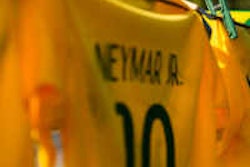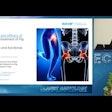
VIENNA - Sports imaging is playing an increasing role in confirming a provisional diagnosis, detecting other conditions, planning and monitoring treatment, and reassuring patients that they can return safely to their activity and there is no significant injury, European Congress of Radiology (ECR) delegates learned at Sunday morning's musculoskeletal refresher course.
It is important to consider not only the mechanism and cause of the injury, but also the associated features, said session moderator Dr. Gina Allen, radiologist and sports physician from the Oxford Soft Tissue Injury Clinic in the U.K. Among the questions to ask are: Is the athletes' technique correct? Has their technique developed as they've grown? Are they eating the right diet? Are they taking additional substances, such as drugs? Have they had previous injuries? Are they overtraining? What is the psychology behind the injury? Are they presenting because they don't want to compete?
 |
| Dr. Gina Allen from Oxford, U.K. All images courtesy of the European Society of Radiology. |
"Imaging is just one key element of the process," noted Allen, a member of the London Olympics 2012 imaging committee. "We're always being asked by the patient, 'How quickly can I get back to my sport?' We don't just have to cope with the pressures of the patient; we also have pressure from the management and the coach to get the athlete back to the sport."
For example, in tendon overuse injuries, it may be that the patients have had improper training or coaching. They may have changed their shoes, altered their equipment, trained at a different altitude, or started playing the sport on a different all-weather surface. These factors must be taken into account, she advised.
Allen said ultrasound is now a core subject in sports medicine training in the U.K., and portable scanners have become the "stethoscope" of the sports physician. However, the modality has its limitations. For instance, acute muscle injuries may be difficult to identify with ultrasound during the first few hours after trauma, according to Dr. Carlo Martinoli, an associate professor of radiology at the University of Genoa in Italy. A new hemorrhage is echogenic and similar in appearance to normal muscle, and a fresh hemorrhage can mix with the normal fibrofatty tissue within the muscle and be inconspicuous in an early ultrasound examination.
 |
| Dr. Carlo Martinoli from Genoa, Italy. |
"It is easy to underestimate or even overlook muscle tears within the first few hours of the injury. This places great demands on image quality and the examiner's skills," said Martinoli, stressing that MRI is more sensitive and reliable immediately after trauma, but then an ultrasound examination can be performed several hours later.
Muscle strains are not the result of muscle contraction alone; in fact, strains are the result of stretching while the muscle is being activated. Muscles are more susceptible to strain injuries because they cross two joints, have a complex architecture, act mainly in an eccentric fashion, and contain a high percentage of fast-twitch (type II) fibers, he explained.
After six hours, the hematoma starts to liquefy, and it becomes of low echogenicity over the next two or three days, allowing greater precision in the diagnosis. The pattern of the hematoma can be better appreciated and understood, but radiologists must make sure they look at the myotendinous junctions and avoid putting too much pressure on the fascial planes, he recommended.
"An in-depth knowledge of muscle anatomy, and the systematic scanning technique of aponeuroses and intramuscular tendons is essential not to miss low-grade muscle strains with ultrasound," said Martinoli.
Ultrasound provides an ideal way of assessing the sequential stages of hematoma reabsorption, which occurs in six to eight weeks. The hemorrhagic cavity progressively shrinks, and its walls thicken and collapse.
 |
| Dr. Üstün Aydingöz, from Ankara, Turkey. |
Compared with ultrasound, MRI can provide a more comprehensive study of musculoskeletal (MSK) structures, including bones. Furthermore, MRI is less time-consuming to evaluate, and during a given period, more MSK MRI investigations can be read, according to Dr. Üstün Aydingöz, a professor of radiology at Hacettepe University School of Medicine in Ankara, Turkey. On the other hand, dynamic studies are not routinely possible with MRI, and ultrasound is clearly more advantageous in this respect.
Radiologists must be aware of the delayed onset of muscle soreness, and muscle contusion does not necessarily occur at the myotendinous junction. Muscle fibers are coarse through the abnormal region, he noted. Myositis ossificans and heterotopic ossification correlate with plain film.
The main advantages of MRI are ease of performance, its broad field-of-view evaluation of an anatomic region, and broad pathological evaluation. The organization of a country's healthcare payment system will have an impact on modality choice in sports imaging, as in any field. Economics may well dictate the selection of a primary study when all modalities perform equivalently, he stated. Ultrasound offers the possibility of lower costs, facilitates dynamic imaging, and generally excels at a directed examination.
Finally, attendees at the course were told to make absolutely sure that they have the patient's full contact information. This point sometimes gets overlooked, said Aydingöz, who has worked as a musculoskeletal radiologist since 1996, and was a visiting professor of radiology at St. Louis University Hospital in Missouri between 2005 and 2009.
Originally published in ECR Today March 7, 2011.
Copyright © 2011 European Society of Radiology



















